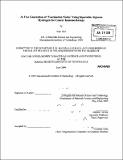In vivo generation of 'vaccination nodes' using injectable alginate hydrogels for cancer immunotherapy
Author(s)
Hori, Yuki
DownloadFull printable version (38.89Mb)
Other Contributors
Massachusetts Institute of Technology. Dept. of Materials Science and Engineering.
Advisor
Darrell J. Irvine.
Terms of use
Metadata
Show full item recordAbstract
Despite the amount of ongoing intensive research, tumor cells have continued to outwit us in the effort to combat and prevent cancer by exerting a number of mechanisms to evade and suppress anti-tumor immune responses. The present work employs strategies to generate a synthetic extranodal immunoplatform that can harbor both exogenously provided and endogenously recruited immune cells (primed against tumor cells), at the same time providing immuno-factors that support these cells and counter immunosuppressive effects from tumors. We have developed injectable self-gelling alginate formulations for this purpose, enabling sustained release of soluble immunomodulatory factors from the gels and presentation of immobilized immunostimulatory factors inside the gels. The hydrogels injected into the back flanks of mice formed a macroporous structure that allowed easy cell infiltration and migration. Modulation of the mechanical properties of self-gelling alginate was possible by varying the number of calcium-bound microspheres in the gels. During characterization of immune responses using these hydrogels, alginate gels carrying activated dendritic cells (DCs) were shown to dramatically increase the number of T cells recruited to the local injection site. When the dendritic cells were pulsed with antigen, these 'vaccination nodes' were able to initiate an antigen-specific immune response, with some of the injected DCs migrating to the regional lymph nodes and priming cognate T cells. The activated antigen-specific T cells then migrated to the injection site and infiltrated the gels, causing an effector re-trafficking phenomenon that guided both T cells and host dendritic cells to the gels. (cont.) Taking advantage of this phenomenon, the ability of the vaccination nodes to serve as a peri-tumoral local therapy against established tumors was tested using an ovalbumin-expressing B16FO subcutaneous melanoma model. When mice bearing 7-day established small tumors (-3mm2 diameter) were immunized using alginate carrying activated DCs, a mild tumor suppression effect was observed. The anti-tumor effect was augmented by supplementing IL-15 superagonist (IL-15SA) into the gels, which caused suppression of larger tumors (-20-50mm2), treated 14 days after tumor cell inoculation, and enhanced survival of the mice. In addition to showing therapeutic benefits against established tumors, the matrix-based approach allowed analysis of cells that trafficked locally near the tumor site. The ease of encapsulating factors and the injectable, non-invasive nature of the self-gelling alginate open up possibilities for use in other tissue engineering and regenerative medicine applications.
Description
Thesis (Ph. D.)--Massachusetts Institute of Technology, Dept. of Materials Science and Engineering, 2009. Cataloged from PDF version of thesis. Includes bibliographical references (p. 78-90).
Date issued
2009Department
Massachusetts Institute of Technology. Department of Materials Science and EngineeringPublisher
Massachusetts Institute of Technology
Keywords
Materials Science and Engineering.